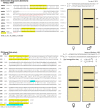Molecular sexing assays in 114 mammalian species: In silico sequence reanalysis and a unified graphical visualization of diagnostic tests
- PMID: 31031962
- PMCID: PMC6476764
- DOI: 10.1002/ece3.5093
Molecular sexing assays in 114 mammalian species: In silico sequence reanalysis and a unified graphical visualization of diagnostic tests
Abstract
Molecular-based methods for identifying sex in mammals have a wide range of applications, from embryo manipulation to ecological studies. Various sex-specific or homologous genes can be used for this purpose, PCR amplification being a common method. Over the years, the number of reported tests and the range of tested species have increased greatly. The aim of the present analysis was to retrieve PCR-based sexing assays for a range of mammalian species, gathering the gene sequences from either the articles or online databases, and visualize the molecular design in a uniform manner. For nucleotide alignment and diagnostic test visualization, the following genomic databases and tools were used: NCBI, Ensembl Nucleotide BLAST, ClustalW2, and NEBcutter V2.0. In the 45 gathered articles, 59 different diagnostic tests based on eight different PCR-based methods were developed for 114 mammalian species. Most commonly used genes for the analysis were ZFX, ZFY, AMELX, and AMELY. The tests were most commonly based on sex-specific insertions and deletions (SSIndels) and sex-specific sequence polymorphisms (SSSP). This review provides an overview of PCR-based sexing methods developed for mammals. This information will facilitate more efficient development of novel molecular sexing assays and reuse of previously developed tests. Development of many novel and improvement of previously developed tests is also expected with the rapid increase in the quantity and quality of available genetic information.
Keywords: PCR; mammals; molecular sexing; sex determination; sex identification.
Conflict of interest statement
None declared.
Figures
References
-
- Beckwitt, R. , Shea, J. , Osborne, D. , Krueger, S. , & Barklow, W. (2002). A PCR‐based method for sex identification in Hippopotamus amphibius. African Zoology, 37(2), 127–130.
-
- Bidon, T. , Frosch, C. , Eiken, H. G. , Kutschera, V. E. , Hagen, S. B. , Aarnes, S. G. , … Hailer, F. (2013). A sensitive and specific multiplex PCR approach for sex identification of ursine and tremarctine bears suitable for non‐invasive samples. Molecular Ecology Resources, 13(3), 362–368. 10.1111/1755-0998.12072 - DOI - PubMed
Publication types
LinkOut - more resources
Full Text Sources
Research Materials


